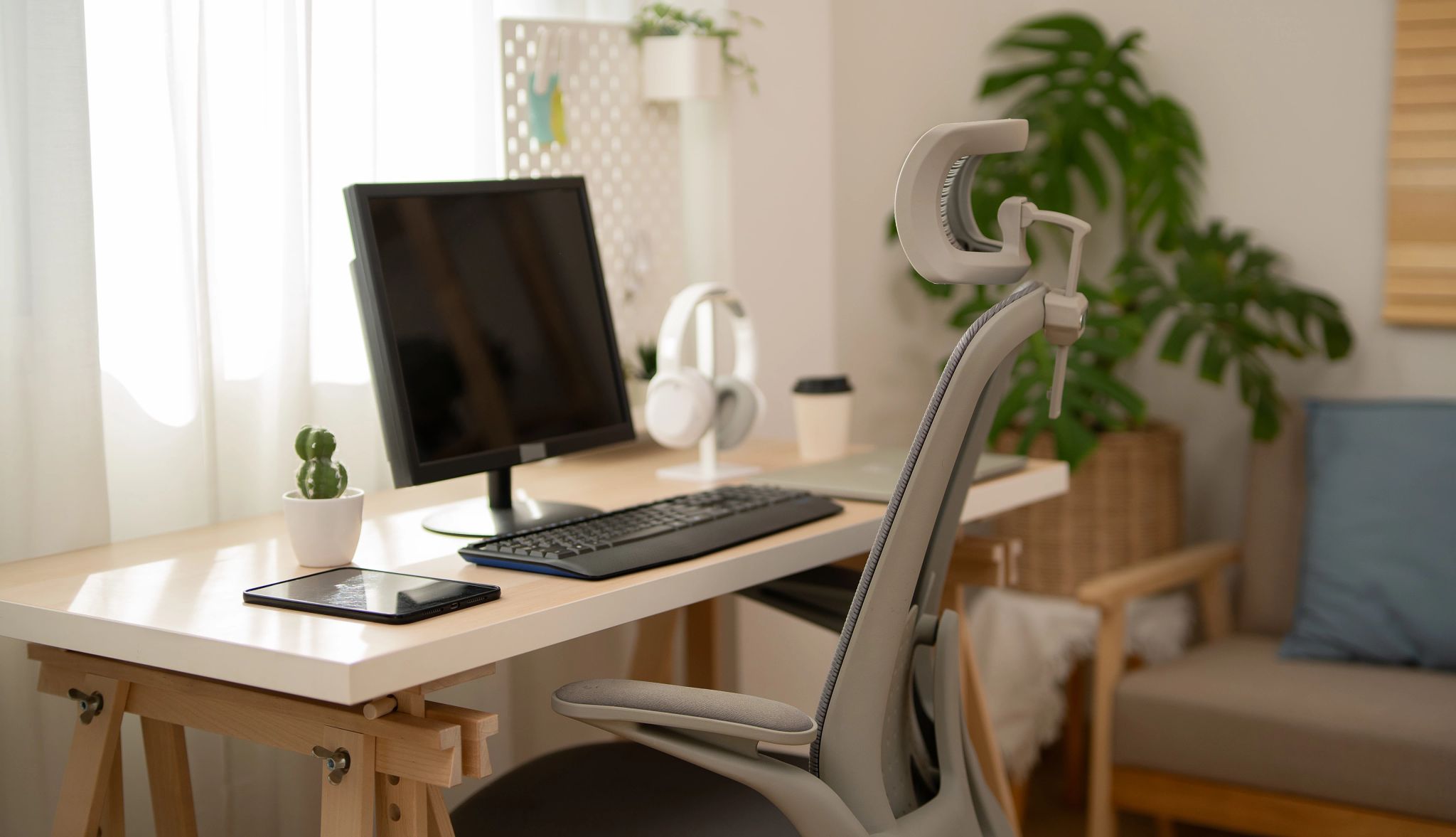AARP Hearing Center


In this story
Finding a remote job • Setting up your are • Managing your workday
• Managing your career
Opportunities for remote work have surged in recent years, which is great news for older workers. According to a 2023 AARP survey, 44 percent of people age 40 and older were remote at least some of the time. The convenience, flexibility and potential for a better work-life balance are some of the factors that attract the 50-plus to work-from home jobs.
While working from home can have its benefits, there can are some potential pitfalls, too. Work-from-home scams have been on the rise in recent years. Setting up your home work space takes time and effort, especially for those who need to be mindful of ergonomics and comfort. And being out of the office can affect your career opportunities and your risks for social isolation.
Each of these problems can be avoided with some careful planning, and millions of workers have found the appeal of remote work outweighs the potential risks. This guide offers the best tips and advice from career and employment experts on how you thrive in a remote-work position.


FINDING A REMOTE JOB
1. Update your resume for remote work
It’s common practice now to update your resume so it specifically fits each job you’re applying for. That means if you’re applying for a work-from-home position, you want to highlight previous experience and skills that show you can be successful in that role. For example, instead of listing the location of where a previous employer was based, consider writing “remote” or “virtual” instead. Quantify how much time you spent working from home, such as “100 percent remote” or “40 percent virtual.”
Another place to highlight your work-from-home experience is in your cover letter, where you can be more descriptive about why you excelled in that role.
Enjoying this free article? AARP Members can access the full "25 Great Ways To ..." series in AARP Members Edition here.
Not a member? Join Today! And unlock access to exclusive members-only content, games, benefits, and more.
2. Use remote-work job boards to find openings
While you can find openings for remote and hybrid positions on large job boards like Indeed and Monster, there are some online job boards that specialize in posting work from home jobs. The free AARP Job Board, which offers postings from some employers who have pledged to support older workers, has a specialized page that offers remote positions from businesses nationwide. FlexJobs features more than 100,000 job postings in a wide range of occupations ($2.95 for a 14-day trial, $23.95 every four weeks thereafter). While it’s not quite a job board, Work At Home Vintage Experts (WAHVE) focuses primarily on connecting older adults with remote jobs, many of them in the fields of insurance, accounting and bookkeeping. After you complete the company’s application process, they match you with positions that fit your skills.
3. Avoid work-from-home scams
The opportunity to work from home is appealing to many jobseekers, which means many scammers are trying to make money exploiting that interest. Common remote-work scams can involve tasks like stuffing envelopes, processing billing forms for medical offices, filling out online surveys, doing typing or data entry, or assembling crafts.
Keeping two things in mind can help you avoid many of these scams. First, legitimate employers will almost never ask you to pay an application fee to be considered for the position. Second, a real employer generally will provide you with the equipment you need to do the job, not ask you to pay for the equipment yourself.


SETTING UP YOUR AREA
4. Make a dedicated workspace
If you’re going to be spending many hours a week working from home, sitting at the kitchen table probably won’t be the best place to do it, says remote work and company culture expert Chris Dyer, author of Remote Work: Redesign Processes, Practices, and Strategies to Engage a Remote Workforce. While not everyone has an extra room to devote to a home office, creating a dedicated workspace with equipment that allows you to focus and get things done is best. This includes a desk with enough room to spread out and a comfortable chair, as well as a laptop — Dyer insists on laptops because they’re so portable — and, sometimes, a second monitor.
A comfortable workspace can be a key to success. An August 2024 study published in PLOS ONE found that Dutch employees experienced higher levels of self-reported productivity and lower levels of burnout when they were satisfied with their home office setups.
5. Pay attention to ergonomics
Ergonomics — the study of how people interact safely and productively with their work surroundings — can make your workspace more comfortable physically and safer for your health. Research from the University of Cincinnati published in October 2020 found subpar ergonomics in home offices was common in the situations they explored. Issues ranged from low monitor heights and nonadjustable chairs to lack of armrests. The research stated that issues arising from improper ergonomics could begin with discomfort and progress into musculoskeletal disorders that could “have direct impact on the companies’ bottom line through treatment costs, compensation costs, and absenteeism and presenteeism.”
Based on the study, make sure you are using a chair that offers support for your lumbar spine and back. The chair also should have armrests that keep your hands comfortably elevated over your laptop’s keyboard. Pay attention to how high your screen is placed, too. You should be looking straight ahead — not down — to see it.
6. Get tips on how to use software you need
Paul Wolfe, human-first leadership advocate and former chief human resources officer at Indeed and Match.com, says it’s important to be comfortable with the technology your team is using for remote work. People over 50 may find that their colleagues might have preconceived notions about their ability to use tech, “so keeping up with the way people communicate is important,” he says.
Whether you’re using videoconferencing and communication platforms like Microsoft Teams or Slack or other preferred technologies such as texting, spend some time with them to understand tools like raising your hand to ask a question or using the chat function on a videoconference. Search on YouTube for short videos that offer step-by-step demonstrations on how to use different types of software you are unfamiliar with.
“Find a younger teammate and ask them to do some reverse mentoring with you on how best to use technology and what the latest and greatest apps and platforms are for communicating with the team,” he suggests.
7. Minimize distractions
The flexibility remote work can provide also can lead to a range of distractions. From a nagging feeling that the laundry needs to be done to a neighbor asking for a favor — after all, you’re home — if you’re not careful, important work time can be wasted. So, it’s important to learn how to minimize distractions.
“We used to coach all of our people to take the stance that when you're at work, at home or not, you're at work, and to not allow people to come in and ask you to watch their dog and watch their kid and take him to the airport and all of that,” Dyer says. He recommends thinking about it this way: If it’s not something you would do while working in an office, it’s probably not something you should do when working from home. “You need to be able to say no and not feel guilty about it, because it's your job,” he says. (Of course, there’s nothing wrong with taking a few minutes to throw a load of laundry into the washer while you’re working.)






































































You Might Also Like
How to Protect Your Retirement Savings
Poor investment returns early can hurt you more than losses later
Save Your Own Life When Home Alone
How to handle 14 threats
Smart Guide to Solo Travel
Your trip, your way, yourself